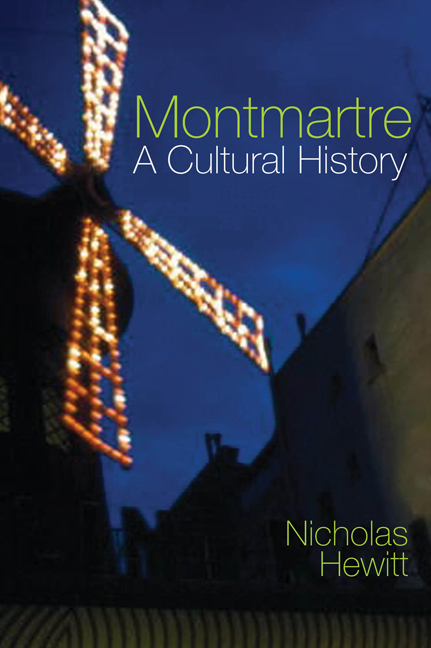Book contents
- Frontmatter
- Dedication
- Contents
- List of Illustrations
- Acknowledgements
- Map
- Introduction
- 1 ‘Montons à la Barrière’
- 2 The Artistic Cabarets
- 3 Music Halls and Mass Culture
- 4 Theatre and the Avant-Garde
- 5 The Bateau-Lavoir and the Lapin Agile
- 6 Wartime and the Années Folles
- 7 The Place of Memory
- 8 The Ecole de Montmartre
- 9 The Occupation: Céline and Aymé
- Epilogue: Montmartre on Film
- Bibliography
- Index
- Plate section
6 - Wartime and the Années Folles
- Frontmatter
- Dedication
- Contents
- List of Illustrations
- Acknowledgements
- Map
- Introduction
- 1 ‘Montons à la Barrière’
- 2 The Artistic Cabarets
- 3 Music Halls and Mass Culture
- 4 Theatre and the Avant-Garde
- 5 The Bateau-Lavoir and the Lapin Agile
- 6 Wartime and the Années Folles
- 7 The Place of Memory
- 8 The Ecole de Montmartre
- 9 The Occupation: Céline and Aymé
- Epilogue: Montmartre on Film
- Bibliography
- Index
- Plate section
Summary
The War Years
By the eve of the First World War, Montmartre, like the Third Republic to which it owed much and whose career it shadowed, was at the pinnacle of its success. It had achieved an unrivalled position as the major pleasure centre of the capital, and a wide international reputation. The music halls of Lower Montmartre were world-renowned for being at the centre of Parisian popular culture and the Butte was the undisputed centre of Parisian bohemia, although, as we have seen, this position was already being contested by Montparnasse. There is general agreement, however, that the declaration of war in August 1914 marked a definitive turning point in Montmartre's privileged position. For Louis Chevalier, ‘With the declaration of war, brutally and in just a few hours, the Montmartre of Pleasure just faded away, with its lights and its shadows, its population of partygoers, its cohorts of prostitutes and pimps, its bandits and even its anarchists. The party was over and another one was about to begin’.
In contrast with the ‘drôle de guerre’ of 1939–40 (the term was, incidentally, invented by Dorgelès in a grand reportage from the Maginot Line), the impact of the First World War on France and, especially, its capital, was immediate: the rapid German advance through Belgium and northern France brought the enemy within thirty kilometres of Paris, entailing the declaration of a state of siege, painfully reminiscent of 1870, the evacuation of the government to Bordeaux and the disorderly flight of many Parisians to the provinces, in scenes which anticipated 1940: ‘Paris deprived of its men of military age, Paris deserted by those who had fled, Paris silent and reflective … Paris is no longer Paris’. The capital was indeed eerily silent and empty. Pierre Darmon notes that a census conducted in September 1914 showed that the overall population had fallen to 1,807,000, a loss of a million compared with 1911 – 950,000 women, 585,000 men and 272,000 children. Movement of the population was seriously limited, with reduced métro and bus services and draconian restrictions on the movement from the banlieue to the capital. With the declaration of a state of siege on 2 August, the ‘ville-lumière’ ceased to exist: ‘streets were empty after 9 p.m., the cafés were in darkness and Paris began to look like a provincial town which had gone to sleep early’.
- Type
- Chapter
- Information
- MontmartreA Cultural History, pp. 145 - 169Publisher: Liverpool University PressPrint publication year: 2017



